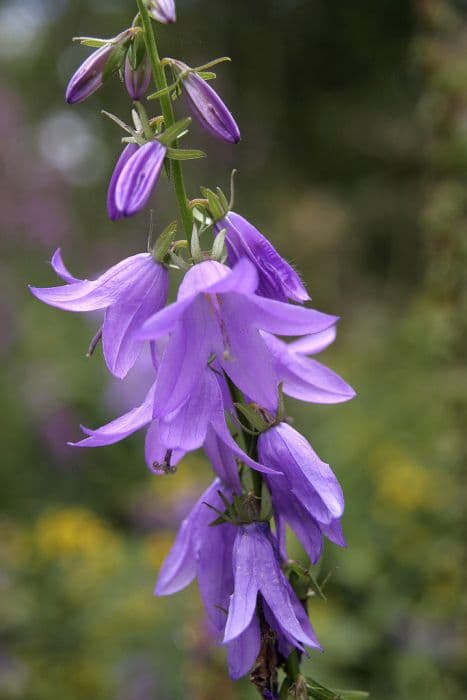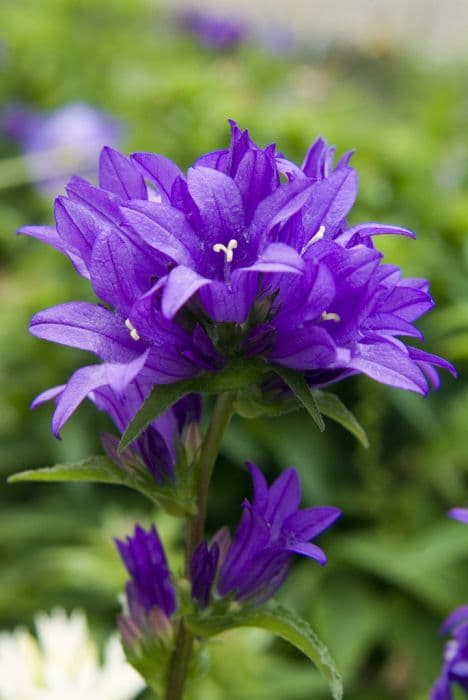Milky Bellflower Campanula lactiflora 'Macrantha'

ABOUT
The Campanula lactiflora 'Macrantha', commonly known as the Milky Bellflower, is a perennial plant with an eye-catching appeal. It possesses a lush, green foliage base comprising numerous, long and narrow leaves that create an appealing backdrop for its flowers. The leaves have a somewhat serrated edge, giving them a textured appearance. The plant is noted for its striking blooms which are large, bell-shaped flowers, hence the name "Bellflower." These blossoms come in a radiant shade of violet-blue, boasting a vibrant and inviting color that can add a splash of cool tones to any garden setting. The flowers are arranged in dense, rounded clusters known as inflorescences, which gracefully adorn the tops of its sturdy, upright stems. The Milky Bellflower displays these charming blooms throughout the summer season, providing a prolonged period of visual interest. With its radiant flowers and robust greenery, this plant serves as a lovely addition to mixed borders, cottage gardens, and can work quite well as a cut flower due to its attractive blossoms.
About this plant
 Names
NamesFamily
Campanulaceae
Synonyms
Milky Bellflower, Broad-leaved Bellflower, Great Bellflower
Common names
Campanula lactiflora 'Macrantha'.
 Toxicity
ToxicityTo humans
The plant commonly known as Milky Bellflower is not known to be toxic to humans. Therefore, ingestion of any part of the Milky Bellflower typically does not result in poisoning or adverse health effects, and no specific symptoms of poisoning are associated with this plant. However, as with any plant material, individual sensitivities can vary, and it's possible for someone to experience an allergic reaction or gastrointestinal upset if they have a specific sensitivity to this plant.
To pets
Milky Bellflower is not commonly listed as a toxic plant to pets. It means that if pets ingest parts of this plant, they are not likely to experience symptoms of poisoning typical of some other plants. However, individual pets may have different sensitivities, and some might experience mild gastrointestinal upset after ingesting it, like vomiting or diarrhea. It's always best to monitor your pet and consult with a veterinarian if you notice any unusual symptoms after ingestion.
 Characteristics
CharacteristicsLife cycle
Perennials
Foliage type
Deciduous
Color of leaves
Green
Flower color
Blue
Height
3-4 feet (0.9-1.2 meters)
Spread
2-3 feet (0.6-0.9 meters)
Plant type
Herb
Hardiness zones
5
Native area
Caucasus
Benefits
 General Benefits
General Benefits- Attracts Pollinators: Provides nectar and pollen for bees, butterflies, and other beneficial insects.
- Aesthetic Appeal: Adds visual interest to gardens with its tall spikes of bell-shaped blue flowers.
- Easy to Grow: Adaptable to a variety of soil types and relatively low maintenance.
- Cottage Garden Plant: Ideal for achieving a traditional cottage garden look due to its height and floral abundance.
- Cut Flowers: The long stems and attractive blooms make it suitable for use in floral arrangements.
- Drought Tolerant: Once established, can tolerate periods of low water supply.
- Perennial Growth: Comes back year after year, providing long-term value for the garden.
- Cold Hardy: Can survive in cooler climates and withstand frosts, making it suitable for a range of growing zones.
- Wildlife Habitat: Can serve as a habitat for small wildlife, offering shelter and food sources within the garden ecosystem.
- Extended Blooming: Blooms for several weeks, typically in the summer, providing prolonged color and interest.
 Medical Properties
Medical PropertiesThis plant is not used for medical purposes.
 Air-purifying Qualities
Air-purifying QualitiesThis plant is not specifically known for air purifying qualities.
 Other Uses
Other Uses- Edible Flowers: The blooms of the Milky Bellflower can be used as a garnish for salads and desserts, adding a subtle touch of color and a mild floral flavor.
- Artistic Inspiration: Artists and photographers may be drawn to the Milky Bellflower for its aesthetic appeal, using its form and color as subjects in their work.
- Educational Tool: Horticulture students and educators can use the Milky Bellflower to study plant growth habits, breeding, and hybridizing techniques due to its distinctive characteristics.
- Fairy Gardens: The delicate look of the Milky Bellflower makes it suitable for inclusion in fairy garden designs, a whimsical gardening trend.
- Dye Production: The petals of the Milky Bellflower could potentially be used to create natural dyes for textiles or crafts, contributing soft blue tones.
- Culinary Decor: Milky Bellflower blooms can adorn cakes or other confections, providing a natural and edible form of decoration.
- Biodegradable Confetti: Dry petals of the Milky Bellflower can serve as an eco-friendly alternative to traditional confetti at celebrations.
- Scented Sachets: The dried flowers can be used in scented sachets to impart a gentle fragrance to drawers and closets.
- Plant Staking: The sturdy stems of the Milky Bellflower may be repurposed as natural stakes for supporting other, more delicate plants in the garden.
- Photography Props: The elegant stems and flowers can be incorporated as props in portrait photography for a touch of natural beauty.
Interesting Facts
 Feng Shui
Feng ShuiThe Milky Bellflower is not used in Feng Shui practice.
 Zodiac Sign Compitability
Zodiac Sign CompitabilityThe Milky Bellflower is not used in astrology practice.
 Plant Symbolism
Plant Symbolism- Gratitude: The Milky Bellflower is often associated with feelings of thankfulness, reflecting a gesture of appreciation when given as a gift.
- Constancy: With its recurring blooms, it symbolizes steadfastness and enduring nature in relationships.
- Humility: The bell-shaped flowers that bow down have been seen as a sign of humility and reverent feelings.
- Versatility: The plant’s ability to grow in various conditions is indicative of adaptability and resilience in life.
- Enduring Love: Perennial by nature, it suggests long-lasting affection and undying love.
 Water
WaterThe Milky Bellflower should be watered regularly to keep the soil moist but not soggy, typically once a week. During hotter months or periods of drought, the frequency may increase to two to three times a week. It is important to check the top inch of soil before watering; if it is dry to the touch, it's time to water. When watering, apply water at the base of the plant until it begins to run out from the bottom of the pot or until the surrounding soil is evenly moist. Aim for about 1 – 1.5 gallons per week, adjusting as needed for weather conditions and soil type.
 Light
LightThe Milky Bellflower thrives best in full sun to partial shade. It should be placed in a location where it receives at least 4 to 6 hours of sunlight daily. However, in very hot climates, some afternoon shade can help prevent scorching of the leaves. Choosing a spot that provides morning sunlight with dappled afternoon shade is often ideal for this plant's growth and flower production.
 Temperature
TemperatureThe Milky Bellflower prefers moderate temperatures and can tolerate a range from approximately 40 to 85 degrees Fahrenheit. It can survive brief periods of colder weather, but should not be exposed to temperatures below 20 degrees Fahrenheit as it can cause damage to the plant. The ideal temperature range for promoting healthy growth and flowering is between 60 and 75 degrees Fahrenheit.
 Pruning
PruningPruning Milky Bellflower is essential to encourage vigorous growth and abundant flowering. After the main bloom, cut back the flower stems to a side shoot or leaf node to promote a second flush of flowers. Pruning should also be done to remove any dead or damaged stems and foliage to maintain plant health. The best time for major pruning is late winter or early spring, before new growth begins.
 Cleaning
CleaningAs needed
 Soil
SoilThe Milky Bellflower prefers well-draining soil rich in organic matter with a pH range of 6.0 to 7.5. A mixture that consists of garden soil, compost, and perlite would support its growth optimally by retaining moisture while avoiding waterlogging.
 Repotting
RepottingMilky Bellflowers, being perennials, don't typically require frequent repotting and can be left undisturbed for several years. They may be divided or repotted every 3-4 years to rejuvenate growth and manage their size.
 Humidity & Misting
Humidity & MistingMilky Bellflowers thrive in average garden humidity conditions; there is no specific humidity requirement. They perform well outdoors where the natural fluctuation of humidity levels provides an adequate environment.
 Suitable locations
Suitable locationsIndoor
Ensure bright indirect light, cool temps, and adequate water.
Outdoor
Plant in partial shade, moist soil, and protect from hot afternoon sun.
Hardiness zone
3-9 USDA
 Life cycle
Life cycleThe Campanula lactiflora 'Macrantha', commonly known as the Milkbowl Bellflower, begins its life as a seed, often sown in spring after the threat of frost has passed. Upon germination, the seedling emerges and develops into a vegetative state, characterized by leaf growth and root development. During this juvenile phase, the plant forms a basal rosette and begins to establish a root system. As the plant matures, it enters the flowering stage, usually in early to mid-summer, producing tall spires of purple or blue bell-shaped flowers that are attractive to pollinators. After pollination, the flowers set seed, which can be dispersed to produce new plants. In the final stage of its life cycle, the plant may either die back at the end of the growing season if it is an annual or prepare for dormancy over the winter if it is a perennial, with the cycle beginning anew the following spring.
 Propogation
PropogationPropogation time
Spring
The most popular method of propagation for the Milky Bellflower, or Campanula lactiflora 'Macrantha', is through division. This technique is best carried out in the spring or early fall. To propagate by division, carefully dig up the plant and separate it into smaller sections, ensuring that each section has a portion of the root system attached. It is important to divide the plant gently to minimize damage to the roots. Once divided, replant the sections at the same depth they were growing at previously, and water them thoroughly to help establish the new plants. This method allows for quick multiplication of the plant while maintaining the characteristics of the parent plant.









